Controlling Factors of Vertical Geochemical Variations in Hydrate-Rich Sediments at the Site GMGS5-W08 in the Qiongdongnan Basin, Northern South China Sea
Abstract
:1. Introduction
2. Geological Setting
3. Samples and Methods
3.1. Sample Collection
3.2. Geochemical Experiments of Gas Samples
3.3. Geochemical Experiments of Sediments
3.3.1. Total Organic Carbon Analyses
3.3.2. Rock-Eval Pyrolysis Analyses
3.3.3. Extractable Organic Matter (EOM) and Gas Chromatography–Mass Spectrometry (GC–MS)
4. Results
4.1. The Geochemical Characteristics of Natural Gas
4.2. Bulk Geochemical Properties of Sediments
4.3. The Compositions of Biomarkers
4.3.1. Normal Alkanes and Acyclic Isoprenoids
4.3.2. Tricyclic Terpanes, Hopanes, and Steranes
4.3.3. Aromatic Distributions
| Depth (mbsf) | MPI-1 | %Rc | TNR-2 | %Rcb | F1 | F2 | DBT/Phen |
|---|---|---|---|---|---|---|---|
| 2.50–2.85 | 0.65 | 0.79 | 0.61 | 0.77 | 0.50 | 0.28 | 1.94 |
| 9.10–9.15 | 0.62 | 0.77 | 0.61 | 0.77 | 0.50 | 0.30 | 1.22 |
| 45.20–45.30 | 0.65 | 0.79 | 0.61 | 0.77 | 0.50 | 0.29 | 1.55 |
| 87.15–87.25 | 0.72 | 0.83 | 0.65 | 0.79 | 0.54 | 0.32 | 1.69 |
| 112.20–112.25 | 0.77 | 0.86 | 0.66 | 0.80 | 0.54 | 0.32 | 2.12 |
| 145.55–145.65 | 0.76 | 0.85 | 0.64 | 0.78 | 0.53 | 0.31 | 2.08 |
| 148.00–148.14 | 0.74 | 0.85 | 0.65 | 0.79 | 0.53 | 0.31 | 2.03 |
| 148.60–148.70 | 0.74 | 0.85 | 0.65 | 0.79 | 0.54 | 0.32 | 1.90 |
| 164.10–164.20 | 0.72 | 0.83 | 0.64 | 0.78 | 0.54 | 0.32 | 1.68 |
| 176.20–176.30 | 0.75 | 0.85 | 0.64 | 0.78 | 0.53 | 0.31 | 1.88 |
| 187.20–187.30 | 0.76 | 0.86 | 0.66 | 0.79 | 0.53 | 0.32 | 1.94 |
5. Discussion
5.1. Origin of Gas Hydrates
5.2. Profile Variations in Geochemical Characteristics of EOM
5.2.1. Basic Geochemical Characteristics
5.2.2. Organic Matter Source
5.2.3. Depositional Environment of Organic Matter
5.2.4. Maturity of Sediment Organic Matter
5.3. Implications for Gas Hydrate Exploration
6. Conclusions
- The decrease in C1 content and increase in δ13C1 with depth suggest an increasing proportion of thermogenic gas, indicating that the MTDs act as cap rocks, impeding the migration of gas from deep source rocks.
- The varying thermogenic gas contributions result in distinct changes in the distribution of sI and sII gas hydrates along the depth profile. It is concluded that MTDs significantly influence the distribution of sII gas hydrates, with important implications for gas hydrate resource assessment and exploration.
- Hydrate-bearing sediments contain both indigenous organic matter and allochthonous hydrocarbons, with the allochthonous hydrocarbons originating from marine source rocks of low to moderate thermal maturity. It is crucial to distinguish the influence of indigenous organic matter when determining the origin of hydrate-related gas sources.
- The vertical distribution patterns of source input, depositional environment, and organic matter maturity parameters within hydrate sediments exhibit distinct trends. These variations at the interfaces closely align with the boundaries of the MTDs, indicating that MTDs prevent upward migration of allochthonous hydrocarbons from depth and have a significant impact on the distribution of organic matter.
Author Contributions
Funding
Data Availability Statement
Acknowledgments
Conflicts of Interest
References
- Sloan, E.D. Gas Hydrates: Review of Physical/Chemical Properties. Energy Fuels 1998, 2, 191–196. [Google Scholar] [CrossRef]
- Paull, C.K.; Dillon, W.P. Natural Gas Hydrates: Occurrence, Distribution, and Detection; American Geophysical Union Geophysical Monograph Series: Washington, DC, USA, 2001. [Google Scholar]
- Sloan, E.D., Jr. Fundamental principles and applications of natural gas hydrates. Nature 2003, 426, 353–359. [Google Scholar] [CrossRef] [PubMed]
- Tréhu, A.M.; Long, P.E.; Torres, M.E.; Bohrmann, G.; Rack, F.R.; Collett, T.S.; Goldberg, D.S.; Milkov, A.V.; Riedel, M.; Schultheiss, P.; et al. Three-dimensional distribution of gas hydrate beneath southern Hydrate Ridge: Constraints from ODP Leg 204. Earth Planet. Sci. Lett. 2004, 222, 845–862. [Google Scholar] [CrossRef]
- Pytlak, L.; Gross, D.; Sachsenhofer, R.F.; Bechtel, A.; Gratzer, R.; Linzer, H.G. Generation, mixing and alteration of thermogenic and microbial gas in oil deposits: The case of the Alpine Foreland Basin (Austria). Mar. Petrol. Geol. 2016, 78, 575–592. [Google Scholar] [CrossRef]
- Makogon, Y.F. Natural gas hydrates—A promising source of energy. Nat. Gas Sci. Eng. 2010, 2, 49–59. [Google Scholar] [CrossRef]
- Wei, J.H.; Liang, J.; Lu, J.; Zhang, W.; He, Y.L. Characteristics and dynamics of gas hydrate systems in the northwestern South China Sea—Results of the fifth gas hydrate drilling expedition. Mar. Pet. Geol. 2019, 110, 287–298. [Google Scholar] [CrossRef]
- Ye, J.; Wei, J.H.; Liang, J.; Lu, J.; Lu, H.; Zhang, W. Complex gas hydrate system in a gas chimney, South China Sea. Mar. Pet. Geol. 2019, 104, 29–39. [Google Scholar] [CrossRef]
- Zhang, W.; Liang, J.; Wei, J.; Su, P.; Lin, L.; Huang, W. Origin of natural gases and associated gas hydrates in the Shenhu area, northern South China Sea: Results from the China gas hydrate drilling expeditions. Asian Earth Sci. 2019, 183, 103953. [Google Scholar] [CrossRef]
- Zhang, W.; Liang, J.Q.; Lu, J.A.; Meng, M.M.; He, Y.L.; Deng, W.; Feng, J. Characteristics and controlling mechanism of typical leakage gas hydrate reservoir forming system in the Qiongdongnan Basin, northern South China Sea. Nat. Gas Ind. 2020, 40, 90–99, (In Chinese with English abstract). [Google Scholar]
- Wei, J.; Wu, T.; Zhu, L.; Fang, Y.; Liang, J.; Lu, H.; Cai, W.; Xie, Z.; Lai, P.; Cao, J.; et al. Mixed gas sources induced co-existence of sI and sII gas hydrates in the Qiongdongnan Basin, South China Sea. Mar. Pet. Geol. 2021, 128, 105024. [Google Scholar] [CrossRef]
- Liang, J.Q.; Zhang, W.; Lu, J.A.; Wei, J.H.; Kuang, Z.G.; He, Y.L. Geological occurrence and accumulation mechanism of natural gas hydrates in the eastern Qiongdongnan Basin of the South China Sea: Insights from site GMGS5-W9-2018. Mar. Geol. 2019, 418, 106042. [Google Scholar] [CrossRef]
- Lai, H.F.; Fang, Y.X.; Kuang, Z.G.; Ren, J.; Liang, J.F.; Lu, J.A.; Wang, G.; Xing, C. Geochemistry, origin and accumulation of natural gas hydrates in the Qiongdongnan Basin, South China Sea: Implications from site GMGS5-W08. Mar. Pet. Geol. 2021, 123, 104774. [Google Scholar] [CrossRef]
- Lai, H.F.; Qiu, H.J.; Liang, J.Q.; Kuang, Z.G.; Fang, Y.X.; Ren, J.F.; Lu, J.A. Geochemical Characteristics and Gas-to-Gas Correlation of Two Leakage-type Gas Hydrate Accumulations in the Western Qiongdongnan Basin, South China Sea. Acta Geol. Sin. (Engl. Ed.) 2022, 2, 680–690. [Google Scholar] [CrossRef]
- Lai, H.F.; Deng, Y.N.; Yang, L.; Liang, J.Q.; Dai, L.R.; Li, L.; Fang, Y.X.; Liu, L.Y.; Kuang, Z.G. Origin of natural gas within the deep-sea uncompacted sediments of the Shenhu area, northern South China Sea: Geochemical and methanogenic cultivation results. Mar. Pet. Geol. 2023, 147, 106015. [Google Scholar] [CrossRef]
- Ding, W.W.; Wang, Y.M.; Chen, H.L.; Yang, S.F.; Wu, N.Y. Deformation characters and its tectonic evolution of the Southwest Taiwan Basin. J.-Zhejiang Univ.-Sci. Ed. 2004, 31, 216–220. [Google Scholar]
- Suess, E.; Huang, Y.; Wu, N.; Han, X.; Su, X. South China Sea continental margin: Geological methane budget and environmental effects of methane emissions and gas hydrates. In Ifm-Geomar, Kiel. Rv Sonne Cruise Report So; GEOMAR: Kiel, Germany, 2005; Volume 177. [Google Scholar]
- Tong, H.P.; Feng, D.; Cheng, H.; Yang, S.X.; Wang, H.B.; Min, A.G.; Edwards, R.L.; Chen, Z.; Chen, D. Authigenic carbonates from seeps on the northern continental slope of the South China Sea: New insights into fluid sources and geochronology. Mar. Pet. Geol. 2013, 43, 260–271. [Google Scholar] [CrossRef]
- He, Y.L.; Liang, J.Q.; Shi, W.Z.; Kuang, Z.; Deng, W.; Wang, R.; Xu, L.; Du, H. Influencing factors and accumulation modes of gas hydrate in the South low uplift and its surrounding area of Qiongdongnan Basin. Earth Sci. 2022, 47, 1711–1727, (In Chinese with English abstract). [Google Scholar]
- Fang, Y.X.; Wei, J.H.; Lu, H.L.; Liang, J.Q.; Lu, J.A.; Fu, J.; Cao, J. Chemical and structural characteristics of gas hydrates from the Haima cold seeps in the Qiongdongnan Basin of the South China Sea. Asian Earth Sci. 2019, 182, 103924. [Google Scholar] [CrossRef]
- He, Y.L.; Liang, J.Q.; Kuang, Z.G.; Deng, W.; Ren, J.F.; Lai, H.F.; Meng, M.M.; Zhang, W. Migration and accumulation characteristics of natural gas hydrates in the uplifts and their slope zones in the Qiongdongnan Basin, China. China Geol. 2022, 5, 234–250. [Google Scholar] [CrossRef]
- Meng, M.M.; Liang, J.Q.; Lu, J.A.; Zhang, W.; Kuang, Z.G.; Fang, Y.X.; He, Y.L.; Deng, W.; Wei, H. Quaternary deep-water sedimentary characteristics and their relationship with the gas hydrate accumulations in the Qiongdongnan Basin, Northwest South China Sea. Deep. Sea Res. Part I Oceanogr. Res. Pap. 2021, 177, 103628. [Google Scholar] [CrossRef]
- Zhu, W.L.; Huang, B.J.; Mi, L.J.; Wilkins, R.W.T.; Fu, N.; Xiao, X.M. Geochemistry, origin, and deep-water exploration potential of natural gases in the Pearl River Mouth and Qiongdongnan basins, South China Sea. AAPG Bull. 2009, 93, 741–761. [Google Scholar] [CrossRef]
- Zhang, Y.D.; Sun, Y.G.; Liu, Q. Distribution and carbon isotope composition of pregnane in carbonate-evaporitic rocks from the Bonan Sag, Bohai Bay Basin, Eastern China: Insights into sources and associated lake environments. Org. Geochem. 2021, 151, 104127. [Google Scholar] [CrossRef]
- Lei, C.; Ren, J.Y.; Pei, J.X.; Lin, H.T.; Yin, X.Y.; Tong, D.J. Tectonic Framework and Multiple Episode Tectonic Evolution in Deepwater Area of Qiongdongnan Basin, Northern Continental Margin of South China Sea. Earth Sci. 2011, 36, 151–162, (In Chinese with English abstract). [Google Scholar] [CrossRef]
- Huang, B.J.; Tian, H.; Li, X.S.; Wang, Z.F.; Xiao, X.M. Geochemistry, origin and accumulation of natural gases in the deepwater area of the Qiongdongnan Basin, South China Sea. Mar. Pet. Geol. 2016, 72, 254–267. [Google Scholar] [CrossRef]
- Su, A.; Chen, H.T.; Chen, X.; Liu, H.P.; Liu, Y.; Lei, M.Z. New insight into origin, accumulation and escape of natural gas in the Songdong and Baodao regions in the eastern Qiongdongnan basin, South China Sea. Nat. Gas Sci. Eng. 2018, 52, 467–483. [Google Scholar] [CrossRef]
- Liang, G.; Gan, J.; Li, X. Genetic types and origin of natural gas in Lingshui sag, Qiongdongnan Basin. China Offshore Oil Gas 2015, 27, 47–53. [Google Scholar]
- Xu, X.D.; Zhang, Y.Z.; Liang, G.; Xiong, X.F.; Li, X.; Guo, X.X.; Liu, H.Y. Hydrocarbon source condition and accumulation mechanism of natural gas in deepwater area of Qiongdongnan Basin, northern South China Sea. Nat. Gas Geosci. 2016, 27, 1985–1992. [Google Scholar]
- Huang, H.T.; Huang, B.J.; Huang, Y.W.; Li, X.; Tian, H. Condensate origin and hydrocarbon accumulation mechanism of the deepwater giant gas field in western South China Sea: A case study of Lingshui 17-2 gas field in Qiongdongnan Basin. Pet. Explor. Dev. 2017, 44, 409–417. [Google Scholar] [CrossRef]
- Zhu, Y.M.; Sun, L.T.; Hao, F.; Tuo, L. Geochemical composition and origin of Tertiary oils in the Yinggehai and Qiongdongnan Basins, offshore South China Sea. Mar. Pet. Geol. 2018, 96, 139–153. [Google Scholar] [CrossRef]
- Gan, J.; Zhang, Y.Z.; Liang, G.; Yang, X.B.; Li, X.; Yang, J.H.; Guo, X.X. On accumulation process and dynamic mechanism of natural gas in the deep water area of central canyon, Qiongdongnan Basin. Acta Geol. Sin. 2018, 92, 2359–2367, (In Chinese with English abstract). [Google Scholar]
- Xie, Y.H.; Zhang, G.C.; Sun, Z.P.; Zeng, Q.B.; Zhao, Z.; Guo, S.A. Reservoir forming conditions and key exploration technologies of Lingshui 17-2 giant gas field in deepwater area of Qiongdongnan Basin. Pet. Res. 2019, 4, 1–18. [Google Scholar] [CrossRef]
- Su, M.; Xie, X.N.; Wang, Z.F.; Jiang, T.; Zhang, C.; He, Y.L. Sedimentary evolution of the central canyon system in Qiongdongnan Basin, northern South China Sea. Acta Pet. Sin. 2013, 34, 467–478, (In Chinese with English abstract). [Google Scholar] [CrossRef]
- Wang, Z.F.; Sun, Z.P.; Zhang, Y.Z.; Guo, M.G.; Zhu, J.T.; Huang, B.J.; Zhang, D.J.; Jiang, R.F.; Man, X.; Zhang, H.Y. Distribution and hydrocarbon accumulation mechanism of the giant deepwater Central Canyon gas field in Qiongdongnan Basin, northern South China Sea. China Pet. Explor. 2016, 21, 54–64, (In Chinese with English abstract). [Google Scholar]
- Hao, S.S.; Huang, Z.L.; Liu, G.D.; Zheng, Y.L. Geophysical properties of cap rocks in Qiongdongnan Basin, South China Sea. Mar. Pet. Geol. 2000, 17, 547–555. [Google Scholar] [CrossRef]
- Espitalié, J.; Deroo, G.; Marquis, F. La pyrolyse Rock-Evaletses applications. Deuxième partie. Rev. L’institut Français Pétrole 1985, 40, 755–784. [Google Scholar] [CrossRef]
- Marzi, R.; Torkelson, B.E.; Olson, R.K. A revised carbon preference index. Org. Geochem. 1993, 20, 1303–1306. [Google Scholar] [CrossRef]
- Bourbonniere, R.A.; Meyers, P.A. Sedimentary geolipid records of historical changes in the watersheds and productivities of Lakes Ontario and Erie. Limnol. Oceanogr. 1996, 41, 352–359. [Google Scholar] [CrossRef]
- Radke, M.; Welte, D.H.; Willsch, H. Geochemical study on a well in the Western Canada Basin: Relation of the aromatic distribution pattern to maturity of organic matter. Geochim. Cosmochim. Acta 1982, 46, 1–10. [Google Scholar] [CrossRef]
- Bao, J.P.; Wang, T.G.; Zhou, Y.Q.; Yu, F.X.; Wang, J.Y.; Zhou, Q.L.; Chen, F.J. The relationship between methyl phenanthrene ratios and the evolution of organic matter. J. Jianghan Pet. Inst. 1992, 14, 8–13, (In Chinese with English abstract). [Google Scholar]
- Radke, M.; Rullkötter, J.; Vriend, S.P. Distribution of naphthalenes in crude oils from the Java Sea: Source and maturation effects. Geochim. Cosmochim. Acta 1994, 58, 3675–3689. [Google Scholar] [CrossRef]
- Milkov, A.V.; Etiope, G. Revised genetic diagrams for natural gases based on a global dataset of >20,000 samples. Org. Geochem. 2018, 125, 109–120. [Google Scholar] [CrossRef]
- Xu, Y.; Shen, P. A Study of Natural Gas Origins in China. AAPG Bull. 1996, 80, 1604–1614. [Google Scholar]
- Klauda, J.B.; Sandler, S.I. Global Distribution of Methane Hydrate in Ocean Sediment. Energy Fuels 2005, 19, 459–470. [Google Scholar] [CrossRef]
- Sassen, R.; Milkov, A.V.; Ozgul, E.; Roberts, H.H.; Hunt, J.L.; Beeunas, M.A.; Chanton, J.P.; Defreitas, D.A.; Sweet, S.T. Gas venting and subsurface charge in the Green Canyon area, Gulf of Mexico continental slope. Org. Geochem. 2003, 34, 1455–1464. [Google Scholar] [CrossRef]
- Chung, H.M.; Gormly, J.R.; Squires, R.M. Origin of gaseous hydrocarbons in subsurface environments: Theoretical considerations of carbon isotope distribution. Chem. Geol. 1988, 71, 97–104. [Google Scholar] [CrossRef]
- Kida, M.; Khlystov, O.; Zemskaya, T.; Takahashi, N.; Minami, H.; Sakagami, H.; Krylov, A.; Hachikubo, A.; Yamashita, S.; Shoji, H. Coexistence of structure I and II gas hydrates in Lake Baikal suggesting gas sources from microbial and thermogenic origin. Geophys. Res. Lett. 2006, 33. [Google Scholar] [CrossRef]
- Klapp, S.A.; Murshed, M.M.; Pape, T.; Klein, H.; Bohrmann, G.; Brewer, P.G.; Kuhs, W.F. Mixed gas hydrate structures at the Chapopote Knoll, southern Gulf of Mexico. Earth Planet. Sci. Lett. 2010, 299, 207–217. [Google Scholar] [CrossRef]
- Bray, E.E.; Evans, E.D. Distribution of n-paraffins as a clue to recognition of source beds. Geochim. Cosmochim. Acta 1961, 22, 2–15. [Google Scholar] [CrossRef]
- Eglinton, G.; Hamilton, R.J. Leaf Epicuticular Waxes: The waxy outer surfaces of most plants display a wide diversity of fine structure and chemical constituents. Science 1967, 156, 1322–1335. [Google Scholar] [CrossRef]
- Peters, K.E.; Walters, C.C.; Moldowan, J.M. The Biomarker Guide: Biomarkers and Isotopes in Petroleum Exploration and Earth History; The Press Syndicate of the University of Cambridge: Cambridge, MA, USA, 2005; Volume 2. [Google Scholar]
- Peters, K.E.; Peters, K.E.; Walters, C.C.; Moldowan, J.M. The Biomarker Guide; Cambridge University Press: Cambridge, MA, USA, 2005; Volume 1. [Google Scholar]
- Xiao, H.; Wang, T.G.; Li, M.J.; Cheng, D.; Yang, Z. Organic geochemical heterogeneity of the Cretaceous Abu Gabra Formation and reassessment of oil sources in the Sufyan sub-basin, Sudan. Org. Geochem. 2021, 162, 104301. [Google Scholar] [CrossRef]
- Shanmugam, G. Significance of coniferous rain forests and related organic matter in generating commercial quantities of oil, Gippsland Basin, Australia. AAPG Bull. 1985, 69, 1241–1254. [Google Scholar] [CrossRef]
- Huang, W.Y.; Meinschein, W.G. Sterols as ecological indicators. Geochim. Cosmochim. Acta 1979, 43, 739–745. [Google Scholar] [CrossRef]
- Ekweozor, C.M.; Strausz, O.P. Tricyclic terpanes in the Athabasca oil sands: Their geochemistry. Adv. Org. Geochem. 1981, 1983, 746–766. [Google Scholar]
- Xiao, H.; Wang, T.G.; Li, M.J.; Fu, J.; Tang, Y.J.; Shi, S.B.; Yang, Z.; Lu, X.L. Occurrence and Distribution of Unusual Tri- and Tetracyclic Terpanes and Their Geochemical Significance in Some Paleogene Oils from China. Energy Fuels 2018, 32, 7393–7403. [Google Scholar] [CrossRef]
- Xiao, H.; Li, M.J.; Yang, Z.; Zhu, Z.L. Distribution patterns and geochemical implications of C19–C23 tricyclic terpanes in source rocks and crude oils occurring in various depositional environments. Geochimica 2019, 48, 161–170, (In Chinese with English abstract). [Google Scholar]
- Bohacs, K.M.; Carroll, A.R.; Neal, J.E.; Mankiewicz, P.J. Lake-basin type, source potential, and hydrocarbon character: An integrated Sequence-Stratigraphic-Geochemical framework. AAPG Stud. Geol. 2000, 46, 3–34. [Google Scholar]


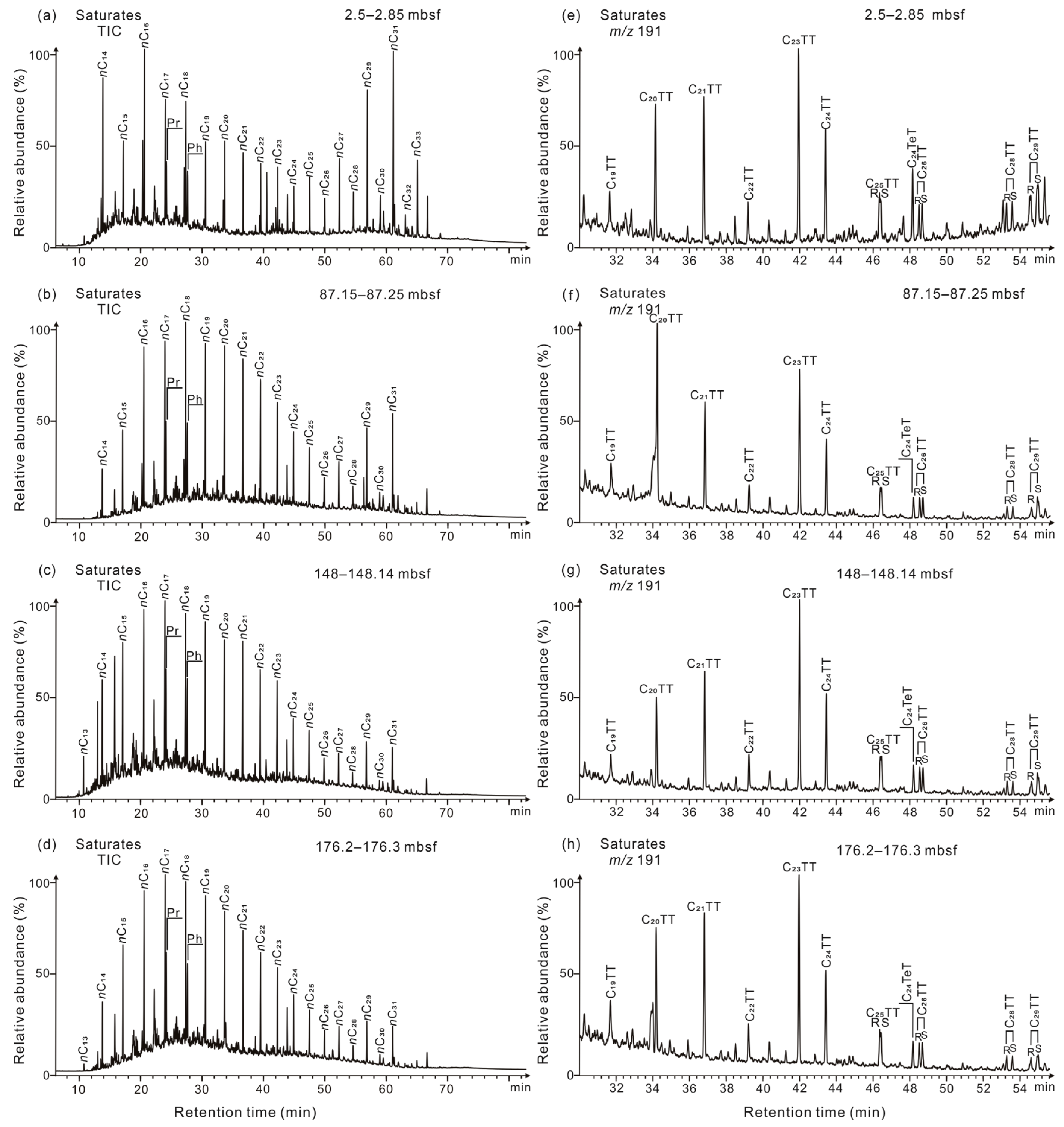
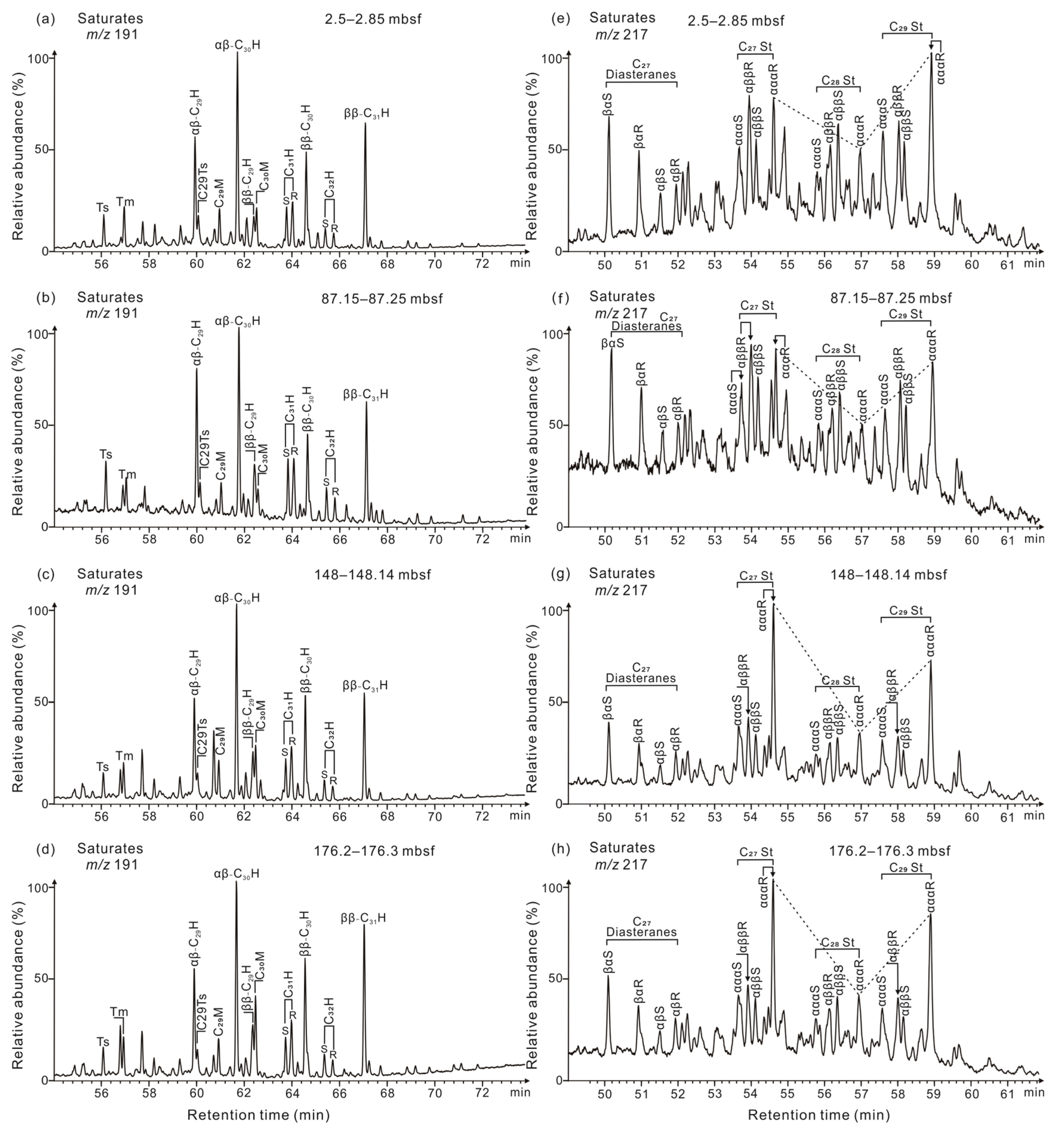
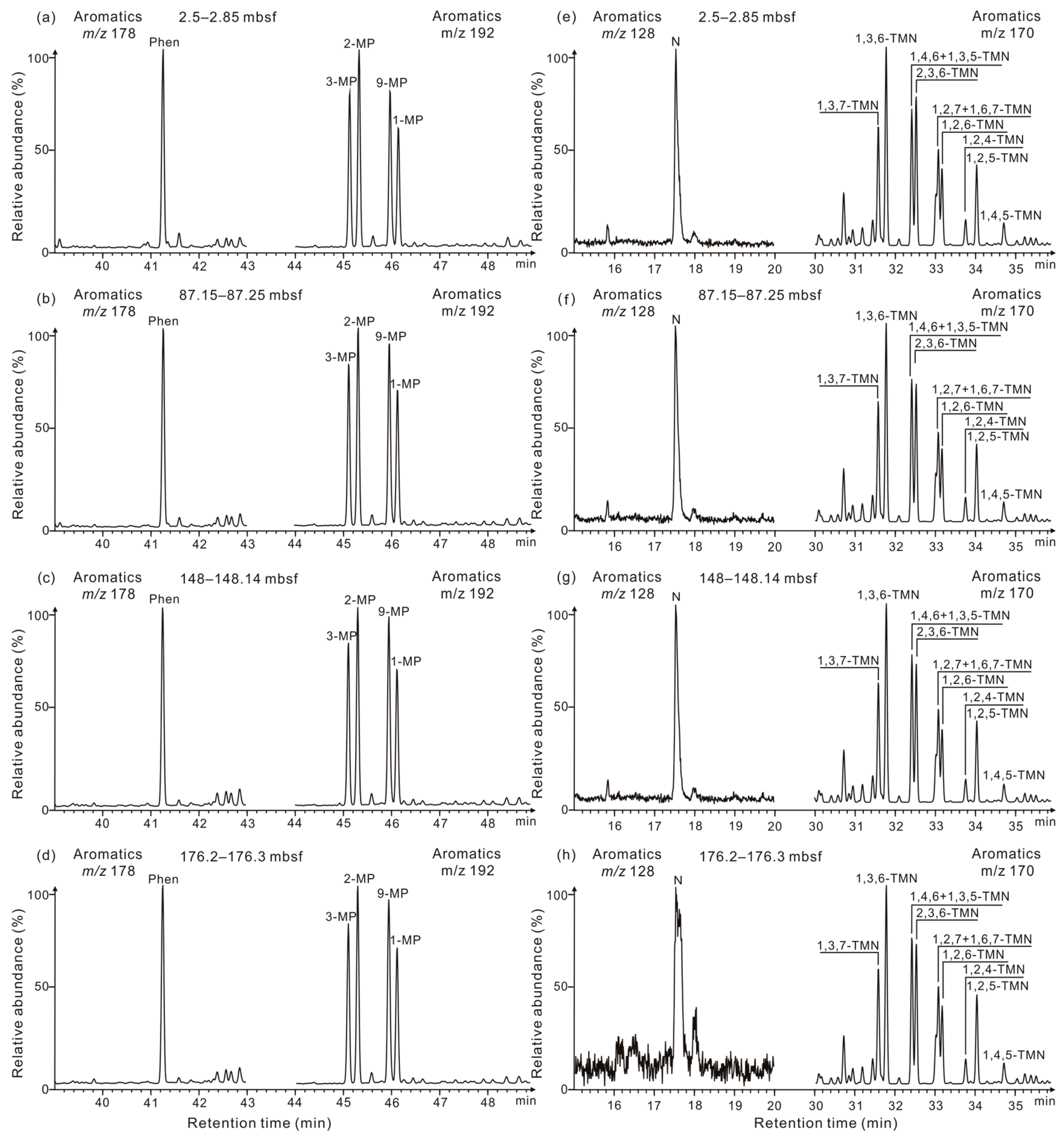
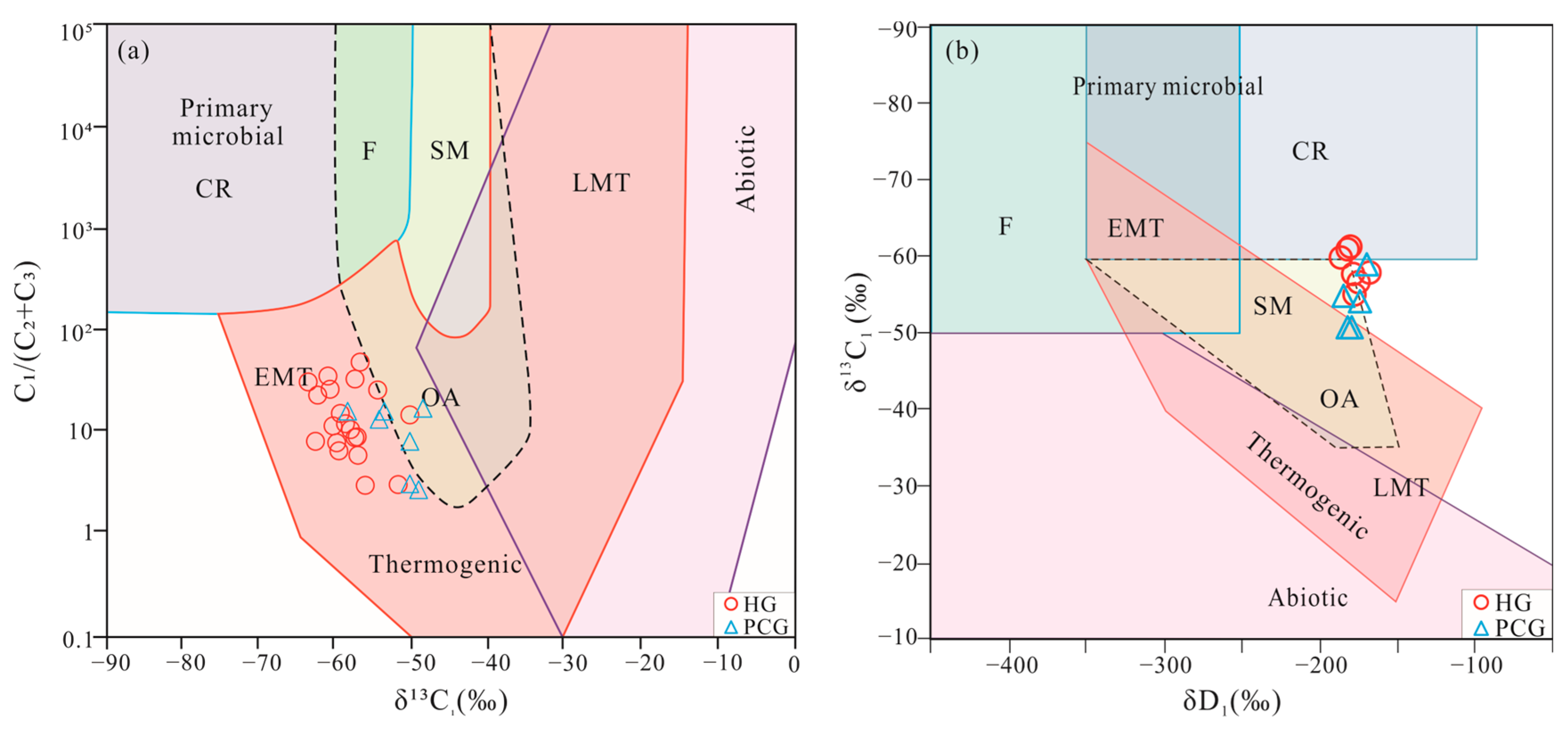
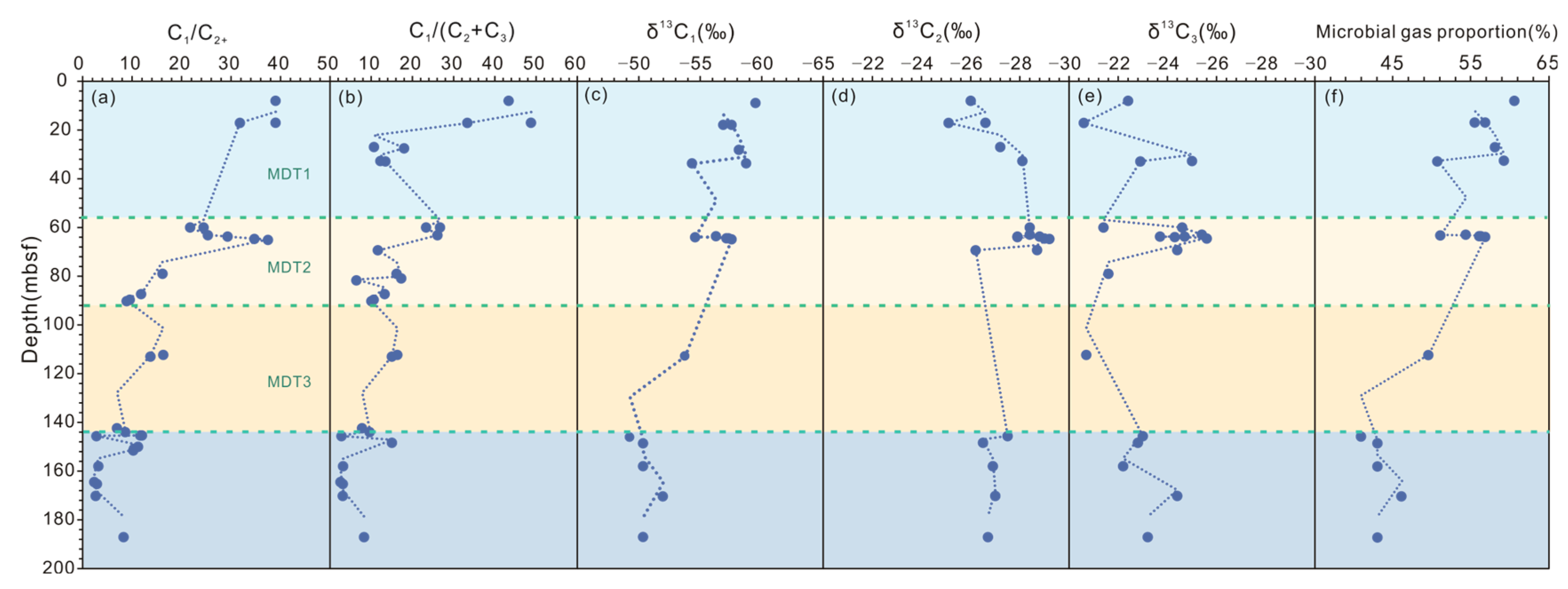
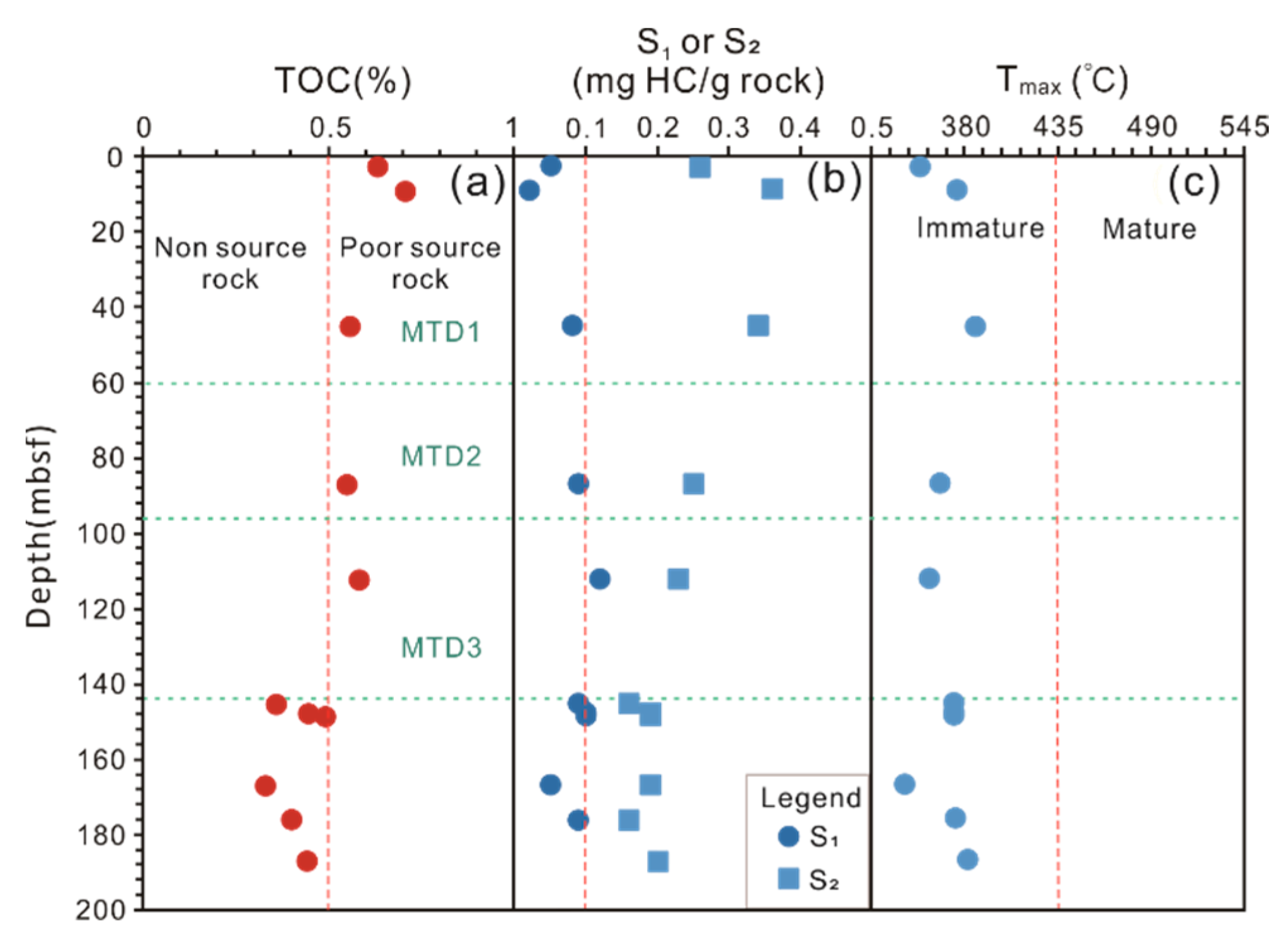

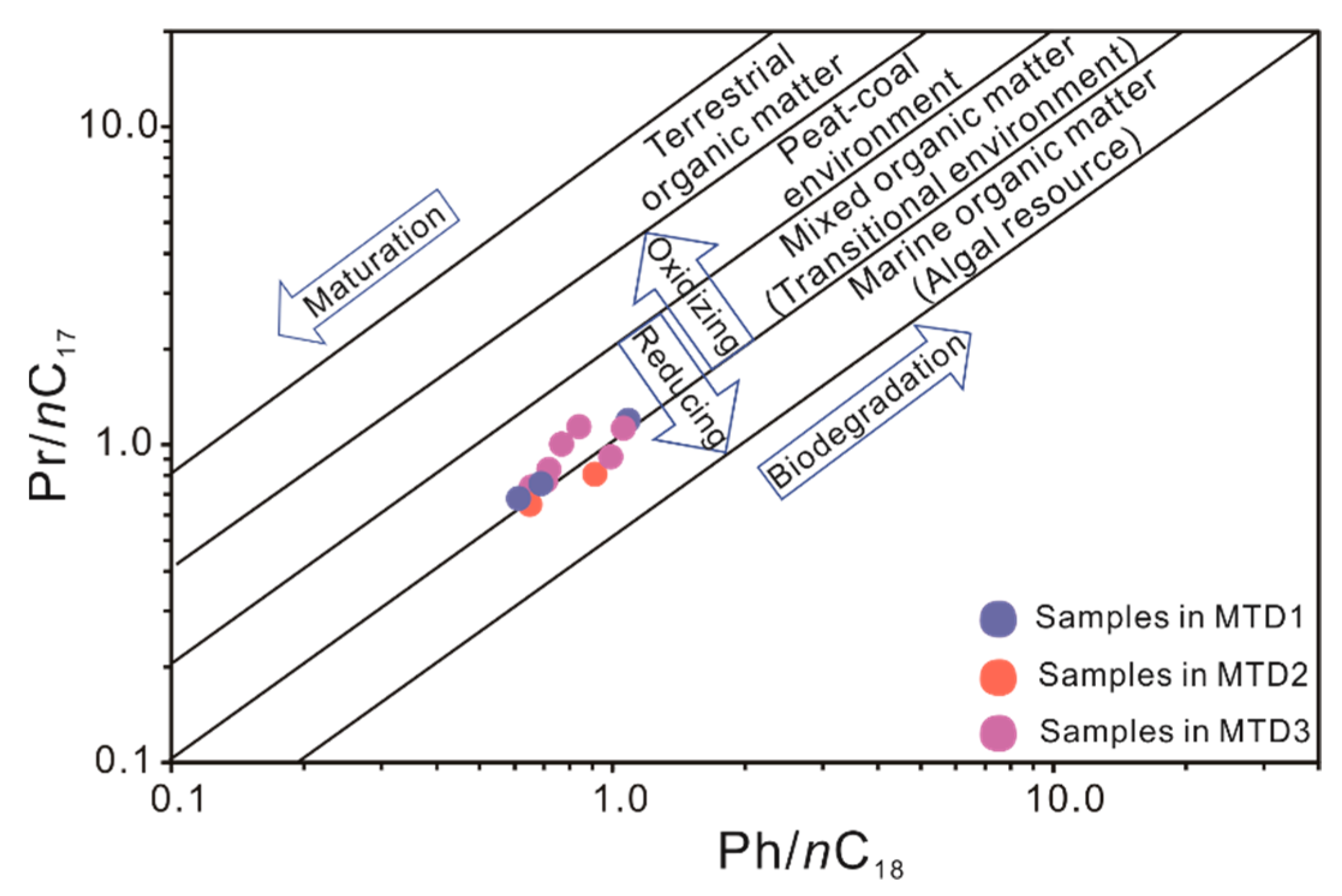
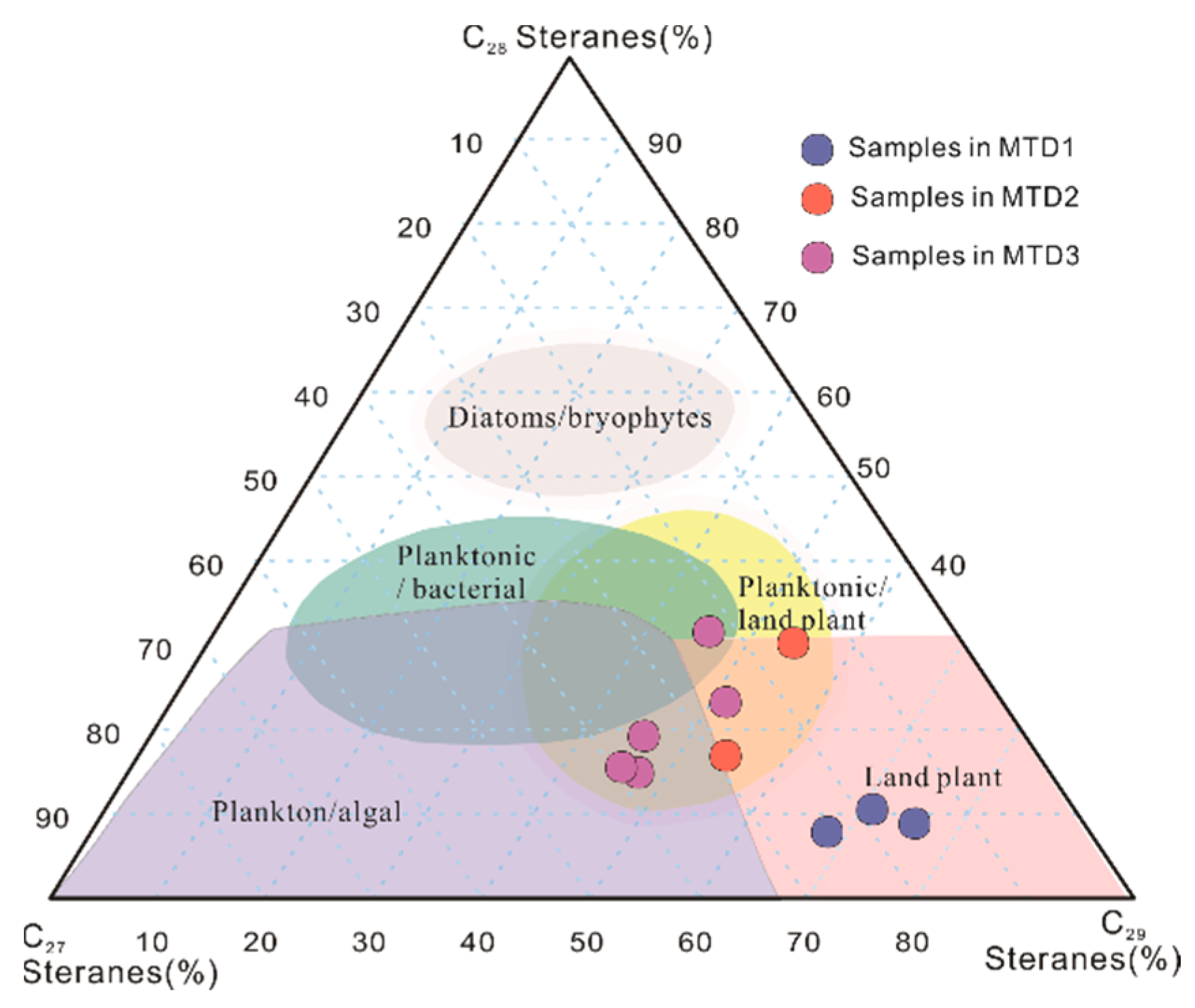
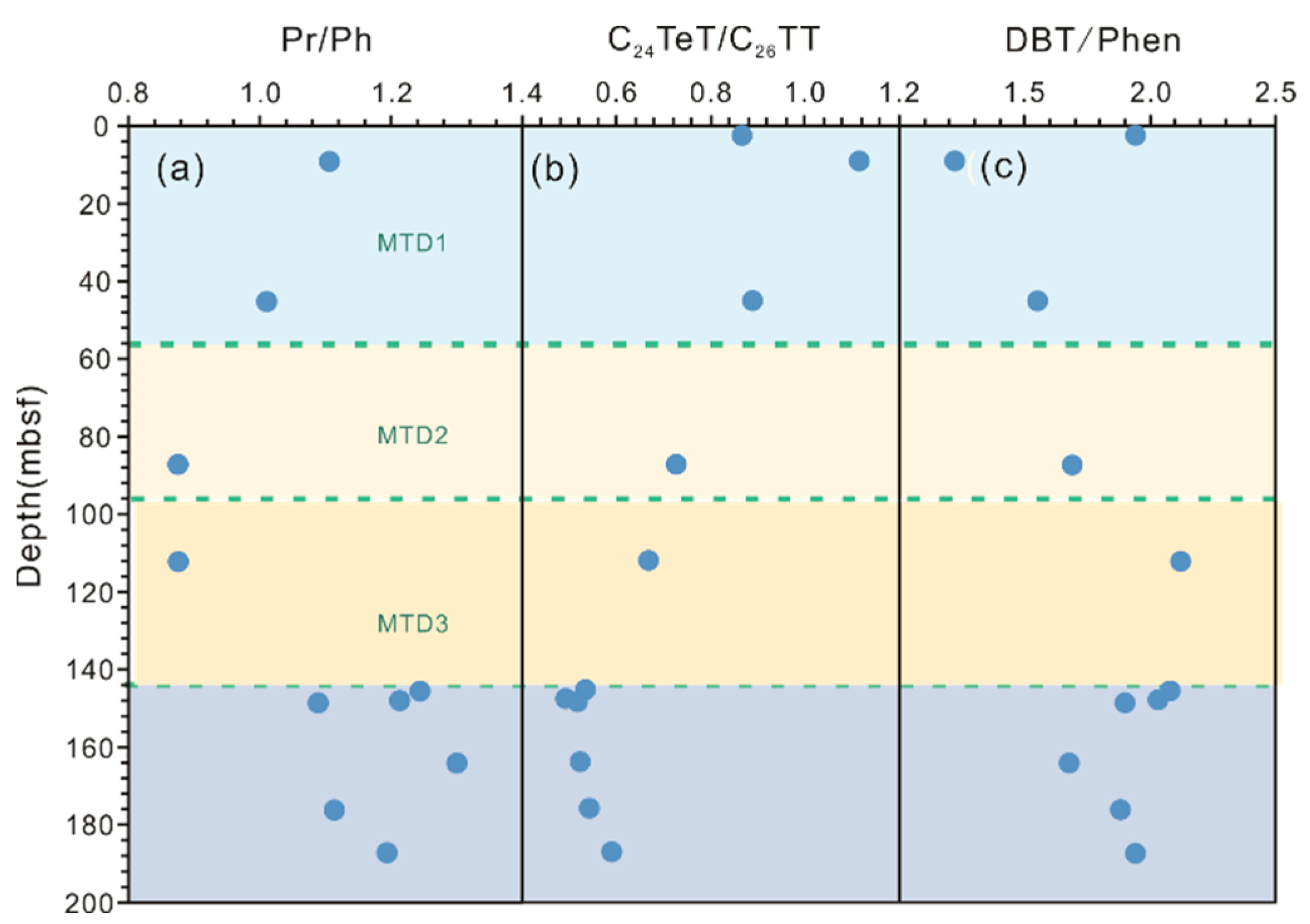

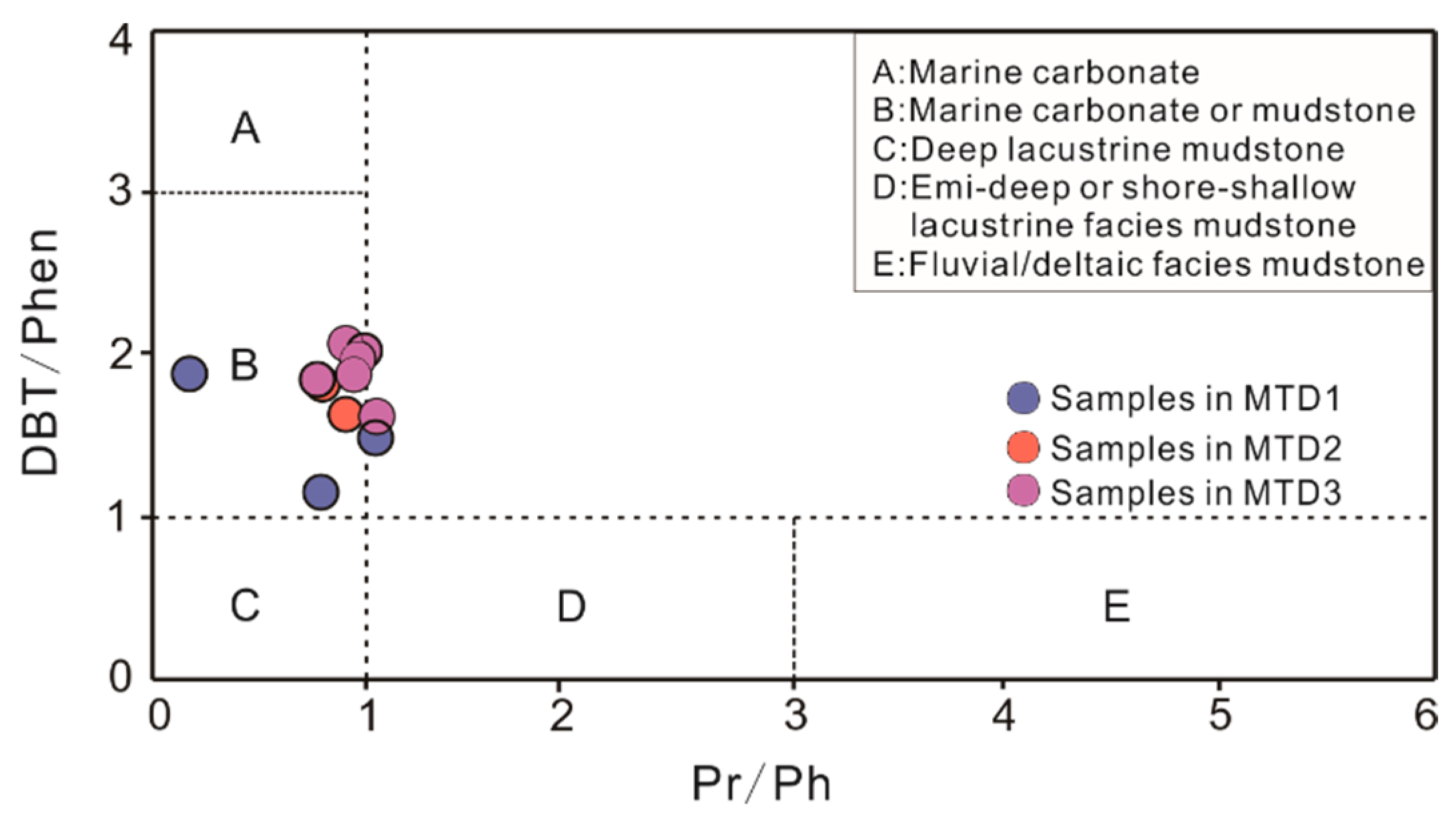
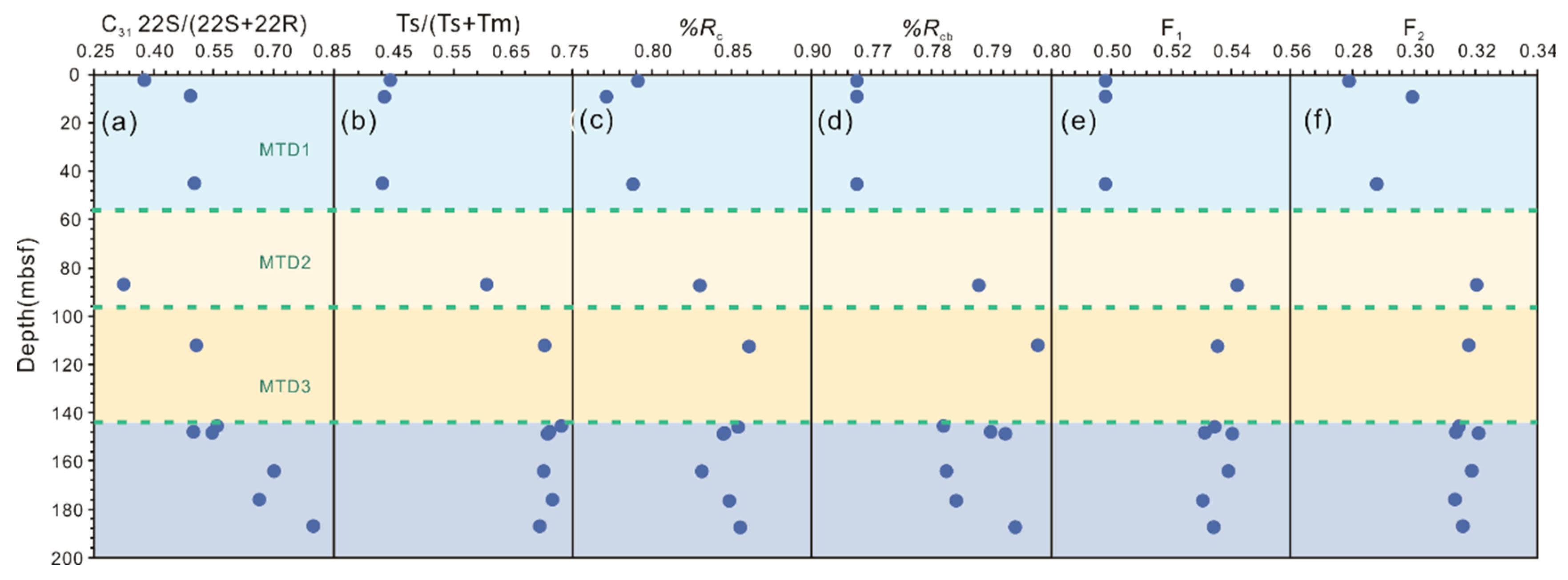
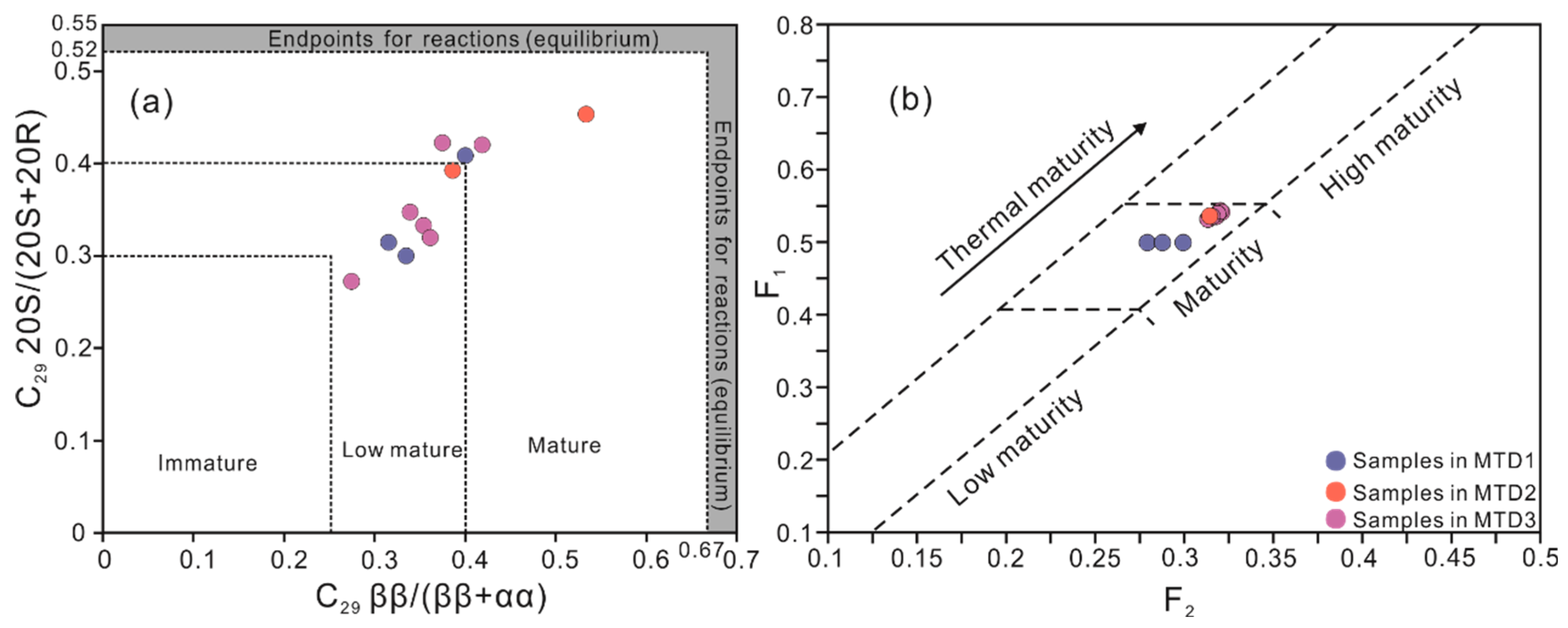
| Depth (mbsf) | Gaseous | C1/(C2 + C3) | Isotopic Composition (‰) | Reference | ||||||
|---|---|---|---|---|---|---|---|---|---|---|
| Hydrocarbon Composition (%) | Molar Ratio | |||||||||
| C1 | C2 | C3 | C3+ | δ13C1 | δ13C2 | δ13C3 | δD1 | |||
| 45 | 97.28 | 2.59 | 0.05 | 0.08 | 36.85 | −58.3 | −25.1 | −20.2 | n.d. | This study |
| 81.23 | 96.37 | 3.27 | 0.25 | 0.11 | 27.38 | −58.8 | −24.5 | −20.2 | n.d. | |
| 146 | 85.19 | 10.43 | 3.5 | 0.88 | 6.12 | −51.2 | −26.6 | −22.7 | n.d. | |
| 8 | 97.5 | 2.2 | 0.05 | 0.25 | 43.33 | −59.5 | −26 | −22.4 | −187 | Data from [14] |
| 17.07 | 96.95 | 2.6 | 0.1 | 0.35 | 33.32 | −57.6 | −26.6 | −20.6 | −169 | |
| 60 | 95.6 | 3.4 | 0.7 | 0.3 | 23.32 | −60.9 | −28.4 | −24.6 | −181 | |
| 63.18 | 96.2 | 3.3 | 0.39 | 0.11 | 26.07 | −54.6 | −22 | n.d. | −178 | |
| 79 | 94.17 | 5.11 | 0.72 | 0 | 16.15 | −58.6 | −25.1 | −21.6 | −170 | |
| 112.3 | 94.22 | 5.02 | 0.75 | 0.01 | 16.33 | −53.8 | −23.3 | −20.7 | −175 | |
| 145.65 | 73.62 | 18.51 | 7.87 | 0 | 2.79 | −49.3 | −27.5 | −23 | n.d. | |
| 158 | 76.1 | 15.43 | 8.48 | 0 | 3.18 | −50.4 | −26.9 | −22.2 | −183 | |
| 187.1 | 89.22 | 6.71 | 4.08 | 0 | 8.27 | −50.4 | −26.7 | −23.2 | −180 | |
| 63.73 | 96.7 | 2.7 | 0.4 | 0.2 | 31.19 | −63.7 | −28.8 | −23.7 | n.d. | Data from [11] |
| 64.7 | 97.2 | 2.5 | 0.2 | 0.1 | 36 | −61.1 | −29.2 | n.d. | n.d. | |
| 170.2 | 72.5 | 12.1 | 11.3 | 4.1 | 3.1 | −52 | −27 | −24.4 | n.d. | |
| 87.35 | 92.2 | 5.3 | 1.65 | 0.85 | 13.27 | n.d. | n.d. | n.d. | n.d. | Data from [8] |
| 89.66 | 90.5 | 6.3 | 2.24 | 0.96 | 10.6 | n.d. | n.d. | n.d. | n.d. | |
| 90.23 | 89.9 | 6.5 | 2.45 | 1.15 | 10.04 | n.d. | n.d. | n.d. | n.d. | |
| 142.39 | 87.4 | 9.3 | 1.94 | 1.36 | 7.78 | n.d. | n.d. | n.d. | n.d. | |
| 164.49 | 70.1 | 17.6 | 9.88 | 2.42 | 2.55 | n.d. | n.d. | n.d. | n.d. | |
| Depth (mbsf) | Lithology | TOC (wt.%) | Tmax (°C) | S1 (mg/g) | S2 (mg/g) | S3 (mg/g) | HI | OI | PI | Organic Extracts (mg/g) | Saturate % | Aromatic % | Resein % | Asphaleten % |
|---|---|---|---|---|---|---|---|---|---|---|---|---|---|---|
| 2.50–2.85 | Silty clay | 0.63 | 370 | 0.05 | 0.28 | 1.50 | 44.11 | 236.29 | 0.15 | 0.99 | 5.15 | 1.46 | 5.92 | 87.47 |
| 9.10–9.15 | Silty clay | 0.71 | 376 | 0.02 | 0.37 | 1.57 | 52.26 | 221.75 | 0.05 | 0.23 | 21.67 | 13.61 | 21.11 | 43.61 |
| 45.20–45.30 | Silty clay | 0.56 | 387 | 0.08 | 0.34 | 1.42 | 60.67 | 253.39 | 0.19 | 0.21 | 19.83 | 17.53 | 15.80 | 46.84 |
| 87.15–87.25 | Silty clay | 0.55 | 366 | 0.09 | 0.25 | 1.23 | 45.45 | 223.64 | 0.26 | 0.33 | 25.47 | 12.17 | 12.17 | 50.19 |
| 112.20–112.25 | Silty clay | 0.58 | 359 | 0.12 | 0.23 | 1.34 | 39.40 | 229.57 | 0.34 | 0.25 | 14.78 | 16.36 | 17.15 | 51.72 |
| 145.55–145.65 | Silty clay | 0.36 | 374 | 0.09 | 0.16 | 1.26 | 44.26 | 348.55 | 0.36 | 0.36 | 7.88 | 4.44 | 1.21 | 86.46 |
| 148.00–148.14 | Silty clay | 0.45 | 374 | 0.10 | 0.19 | 1.24 | 42.53 | 277.59 | 0.34 | 0.31 | 3.68 | 11.95 | 8.28 | 76.09 |
| 148.60–148.70 | Silty clay | 0.49 | 374 | 0.10 | 0.19 | 1.12 | 38.61 | 227.60 | 0.34 | 0.24 | 13.20 | 3.37 | 16.57 | 66.85 |
| 164.10–164.20 | Silty clay | 0.45 | 373 | 0.10 | 0.18 | 1.13 | 40.00 | 251.11 | 0.36 | 0.25 | 13.20 | 3.37 | 16.57 | 66.85 |
| 176.20–176.30 | Silty clay | 0.40 | 375 | 0.09 | 0.16 | 1.24 | 39.92 | 309.38 | 0.36 | 0.36 | 18.18 | 4.71 | 11.45 | 65.66 |
| 187.20–187.30 | Silty clay | 0.44 | 382 | 0.11 | 0.20 | 1.18 | 45.19 | 266.61 | 0.35 | 0.37 | 19.44 | 5.30 | 13.13 | 62.12 |
| Depth (mbsf) | n-Alkanes and Isoprenoid Ratios | Terpanes | Steranes | ||||||||||||
|---|---|---|---|---|---|---|---|---|---|---|---|---|---|---|---|
| Max. Peak | Pr/ Ph | Pr/ nC17 | Ph/ nC18 | ∑nC22+/∑nC21− | CPI | OEP | TAR | C23TT/ C21TT | C24TeT/ C26TT | Ts/ (Ts + Tm) | St.C3122S /(22S + 22R) | St.C2920S/ (20S + 20R) | St.C29ββ/ (ββ + αα) | C27 Diasterane/St.C27 | |
| 2.50–2.85 | nC16, nC31 | 0.22 | 0.85 | 4.78 | 0.76 | 1.21 | 1.23 | 0.47 | 2.14 | 0.86 | 0.44 | 0.38 | 0.42 | 0.41 | 0.67 |
| 9.10–9.15 | nC16, nC31 | 1.11 | 0.74 | 0.66 | 1.08 | 2.02 | 2.26 | 1.70 | 1.32 | 1.11 | 0.43 | 0.39 | 0.39 | 0.36 | 0.75 |
| 45.20–45.30 | nC16, nC31 | 1.01 | 0.71 | 0.61 | 1.09 | 1.88 | 2.09 | 1.56 | 1.39 | 0.89 | 0.43 | 0.40 | 0.31 | 0.30 | 0.42 |
| 87.15–87.25 | nC16, nC31 | 0.88 | 0.77 | 0.70 | 1.03 | 0.86 | 0.71 | 0.23 | 2.24 | 0.72 | 0.60 | 0.32 | 0.41 | 0.39 | 0.70 |
| 112.20–112.25 | nC16, nC31 | 0.88 | 0.65 | 0.65 | 0.66 | 1.55 | 1.82 | 0.58 | 1.50 | 0.67 | 0.70 | 0.51 | 0.58 | 0.47 | 0.58 |
| 145.55–145.65 | nC17 | 1.24 | 0.83 | 0.72 | 0.64 | 0.83 | 0.65 | 0.13 | 1.63 | 0.53 | 0.73 | 0.50 | 0.32 | 0.35 | 0.59 |
| 148.00–148.14 | nC17 | 1.21 | 0.68 | 0.63 | 0.73 | 0.83 | 0.68 | 0.19 | 1.65 | 0.49 | 0.71 | 0.50 | 0.43 | 0.35 | 0.68 |
| 148.60–148.70 | nC17 | 1.09 | 0.73 | 0.73 | 0.75 | 1.81 | 2.19 | 0.75 | 1.45 | 0.51 | 0.70 | 0.53 | 0.33 | 0.34 | 0.64 |
| 164.10–164.20 | nC17 | 1.30 | 1.00 | 0.77 | 0.88 | 0.89 | 0.89 | 0.35 | 1.39 | 0.52 | 0.70 | 0.56 | 0.27 | 0.27 | 0.29 |
| 176.20–176.30 | nC17 | 1.11 | 0.73 | 0.66 | 0.49 | 1.37 | 1.56 | 0.29 | 1.38 | 0.54 | 0.71 | 0.54 | 0.30 | 0.34 | 0.52 |
| 187.20–187.30 | nC17 | 1.19 | 0.76 | 0.69 | 0.50 | 1.46 | 1.73 | 0.37 | 1.44 | 0.59 | 0.69 | 0.55 | 0.34 | 0.33 | 0.65 |
Disclaimer/Publisher’s Note: The statements, opinions and data contained in all publications are solely those of the individual author(s) and contributor(s) and not of MDPI and/or the editor(s). MDPI and/or the editor(s) disclaim responsibility for any injury to people or property resulting from any ideas, methods, instructions or products referred to in the content. |
© 2024 by the authors. Licensee MDPI, Basel, Switzerland. This article is an open access article distributed under the terms and conditions of the Creative Commons Attribution (CC BY) license (https://creativecommons.org/licenses/by/4.0/).
Share and Cite
Liu, H.; Li, M.; Lai, H.; Fu, Y.; Kuang, Z.; Fang, Y. Controlling Factors of Vertical Geochemical Variations in Hydrate-Rich Sediments at the Site GMGS5-W08 in the Qiongdongnan Basin, Northern South China Sea. Energies 2024, 17, 412. https://doi.org/10.3390/en17020412
Liu H, Li M, Lai H, Fu Y, Kuang Z, Fang Y. Controlling Factors of Vertical Geochemical Variations in Hydrate-Rich Sediments at the Site GMGS5-W08 in the Qiongdongnan Basin, Northern South China Sea. Energies. 2024; 17(2):412. https://doi.org/10.3390/en17020412
Chicago/Turabian StyleLiu, Huaxin, Meijun Li, Hongfei Lai, Ying Fu, Zenggui Kuang, and Yunxin Fang. 2024. "Controlling Factors of Vertical Geochemical Variations in Hydrate-Rich Sediments at the Site GMGS5-W08 in the Qiongdongnan Basin, Northern South China Sea" Energies 17, no. 2: 412. https://doi.org/10.3390/en17020412





